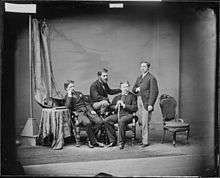Henry Howard (diplomat)
Sir Henry Howard GCMG KCB (11 August 1843 – 4 May 1921) was a British diplomat who was the first formal British envoy to the Vatican for over 300 years.
.jpg)

Biography
Henry Howard was the elder son of Sir Henry Francis Howard, also a British diplomat and ambassador, through whom he was a descendant of Lord William Howard, younger son of Thomas Howard, 4th Duke of Norfolk.[1] He was a member of the Howard family, a Roman Catholic, and was educated at Downside School.[2]
He joined the Diplomatic Service as an attaché to the Legation in Washington, D.C. in 1865. He was promoted to Third Secretary in 1869[3] and to Second Secretary in 1873.[4] While in Washington he was Her Majesty's Agent for British claims under the Treaty of Washington (1871).[5] For this service, he was invested as a Companion of the Order of the Bath (CB) in 1874,[6] after he had left Washington. He then served in The Hague, and, in early 1876, was in London as secretary to a Royal Commission on Fugitive Slaves.[7] After this he was posted back to Washington, then to Guatemala in 1883.
In 1885, Howard was promoted again to be Secretary to the legation at Athens,[8] and subsequently held the same post at the legations at Copenhagen,[9] Peking[10] and St Petersburg.[11] In 1894, he was appointed Secretary to the embassy at Paris.[12] In 1896, he was appointed minister to the Netherlands and also to Luxembourg.[13] While at The Hague, Howard was knighted KCMG, in January 1899,[14] and, a few months later, he was named as British co-representative (with Sir Julian Pauncefote) at the Hague Convention of 1899.[15] Sir Henry was promoted to Knight Commander of the Order of the Bath (KCB) in the King's Birthday Honours of 1907.[16] In October 1908 he left The Hague after presenting his letters of recall to Queen Wilhelmina, who conferred on him the Order of Orange-Nassau.[17] Some of his furniture and effects were shipped on the Great Eastern Railway Company's ship Yarmouth which sank with all hands on its way from Hook of Holland to Harwich on 27 October 1908.[18]
In December 1914, after the outbreak of the First World War, Sir Henry was appointed "His Majesty's Envoy Extraordinary and Minister Plenipotentiary on a Special Mission to His Holiness the Pope"[19] (Benedict XV, who had been elected that September). Sir Henry was accompanied by a member of Foreign Office staff to be Secretary of the mission.[2] This appointment established full diplomatic relations with the Holy See for the first time since 1558[20] (although the United Kingdom had been intermittently represented at the Vatican during the 19th century by diplomats accredited to Italian states). Sir Henry's instructions, in a letter to him from the Foreign Secretary, Sir Edward Grey, were published in a parliamentary paper (Cd.7736):
You will ... in presenting your letters of credence to his Holiness, and offering him the cordial congratulations of his Majesty the King on the occasion of his election, intimate to him that his Majesty's Government are anxious to put themselves into direct communication with him for the purpose of demonstrating the motives which have governed their attitude since the first moment that the normal relations between the Great Powers of Europe began to be disturbed and of establishing that his Majesty's Government used every effort to maintain the peace of Europe which his Holiness' venerated predecessor had so much at heart.[21]
In August 1916 Sir Henry retired from the Diplomatic Service and was appointed GCMG "in recognition of his long and eminent services, and on the occasion of his retirement."[22] He died in Rome on 4 May 1921.[23]
| Diplomatic posts | ||
|---|---|---|
| Preceded by Sir Horace Rumbold, 8th Baronet |
Envoy Extraordinary and Minister Plenipotentiary to the Court of The Hague and Envoy Extraordinary and Minister Plenipotentiary to His Royal Highness the Grand Duke of Luxemburg 1896–1908 |
Succeeded by George Buchanan |
| Preceded by no representation |
Envoy Extraordinary and Minister Plenipotentiary on a Special Mission to His Holiness the Pope 1914–16 |
Succeeded by John Francis Charles, 7th Count de Salis-Soglio |
Family
On 2 October 1867 Henry Howard married Cecilia Riggs, daughter of George Washington Riggs. They had three daughters and two sons. Lady Howard (as she became) died on 3 December 1907.[24]
References
- HOWARD, Sir Henry, Who Was Who, A & C Black, 1920–2008; online edn, Oxford University Press, Dec 2007, accessed 30 May 2012
- Sir Henry Howard – thepeerage.com
- British Mission to the Pope, The Times, 12 December 1914, page 9
- The London Gazette, 17 August 1869
- The London Gazette, 14 February 1873
- The London Gazette, 30 June 1871
- The London Gazette, 24 February 1874
- Elaine Harrison, Office-Holders in Modern Britain: Volume 10: Officials of Royal Commissions of Inquiry 1870-1939, Institute of Historical Research, 1995
- The London Gazette, 17 April 1885
- The London Gazette, 15 January 1886
- The London Gazette, 23 September 1887
- The London Gazette, 23 December 1890
- The London Gazette, 18 September 1894
- The London Gazette, 20 October 1896
- The London Gazette, 10 January 1899
- The Times, London, 11 April 1899, page 9
- Supplement to the London Gazette, 8 November 1907
- The Times, London, 15 October 1908, page 11
- The Times, London, 18 January 1910, page 3
- The London Gazette, 1 January 1915
- UK-Holy See relations Archived 20 October 2012 at the Wayback Machine – British Embassy, Holy See
- The British Mission to the Vatican – Envoy's Instructions, The Times, London, 2 January 1915, page 7
- The London Gazette, 18 August 1916
- The Times, London, 10 May 1921, page 14
- Cecilia Riggs – thepeerage.com